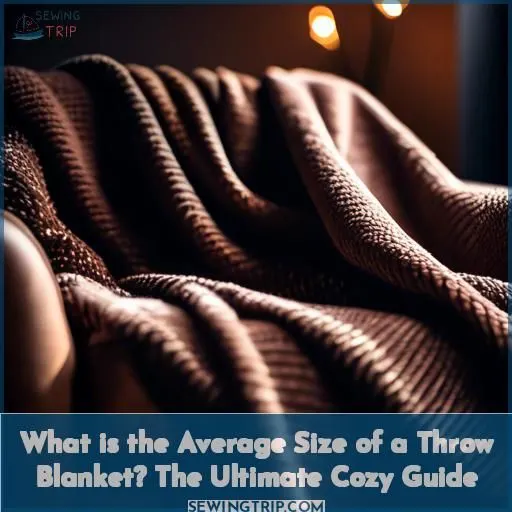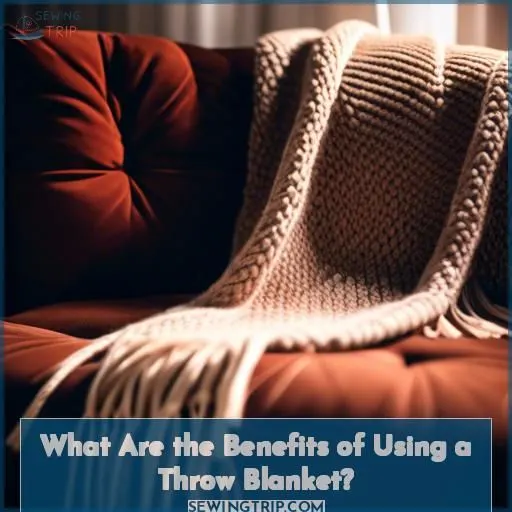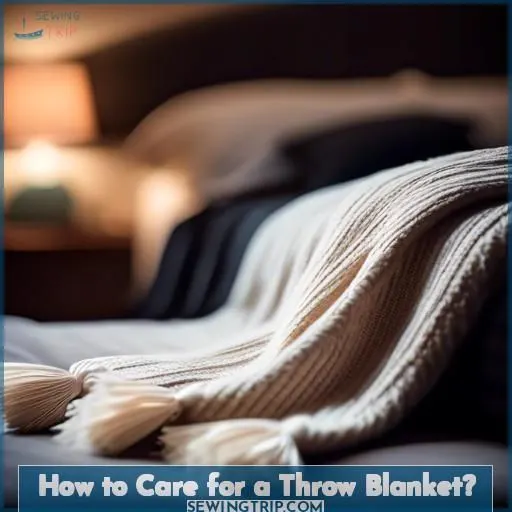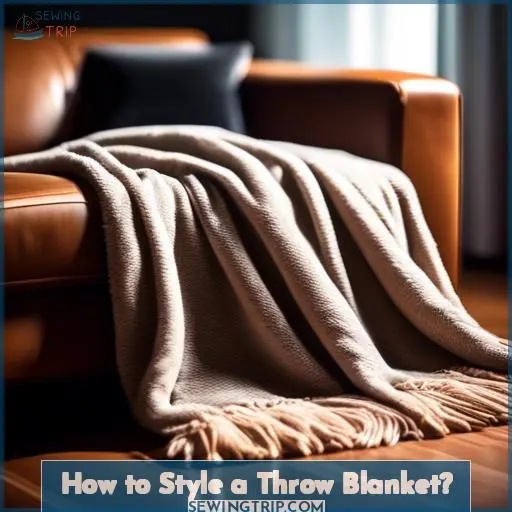This site is supported by our readers. We may earn a commission, at no cost to you, if you purchase through links.
The average size of a throw blanket is around 50 inches wide by 60 inches tall.
However, they come in a range from small (30×40 inches) to large (80×90 inches) and oversized (108×100 inches).
You’ll want to consider the intended use, personal preference, and space when selecting the ideal size.
For example, match your height for personal use or the furniture proportions for decorative balance.
The choice ultimately depends on your climate, usage needs, and style preferences.
Want to learn more about choosing the perfect cozy throw blanket size?
Table Of Contents
- Key Takeaways
- What is the Average Size of a Throw Blanket?
- What is the Average Size of a Throw Blanket?
- Standard Throw Blanket Dimensions Are Typically Around 50 Inches Wide by 60 Inches Tall
- Throw Blanket Sizes Can Range From Small (30 Inches X 40 Inches) to Large (80 Inches X 90 Inches) and Oversized (108 Inches X 100 Inches)
- The Choice of Throw Blanket Size Depends on the Intended Use, Personal Preference, and the Space Where It Will Be Used
- What Are the Benefits of Using a Throw Blanket?
- Throw Blankets Are Versatile and Can Be Used for Decoration, Warmth, or Both
- They Are Lightweight and Easy to Add or Remove From Bedding
- Throw Blankets Can Complement Other Bedroom Accessories, Such as Pillows and Coverlets
- They Can Be Found on Couches, Chairs, and Other Furniture, Adding Color and Texture to a Room
- Throw Blankets Can Be Used to Keep Warm in Bed or for Casual Use
- How to Choose the Right Throw Blanket Size?
- Consider Height, Furniture Size, and Style When Choosing a Throw Blanket Size
- Short or Tall Individuals May Need to Adjust for Height
- Smaller Blankets Are Suitable for Petite Furniture
- Larger Blankets Are for Expansive Rooms or a Dramatic Effect
- Choose a Throw Blanket That Complements Your Height for Personal Use
- Match the Size of Your Throw Blanket to the Proportions of Your Furniture to Achieve a Balanced Look
- Consider the Climate, Usage, and Personal Preference When Choosing the Size of a Throw Blanket
- What Are the Differences Between Throw Blankets and Bed Blankets?
- Throw Blankets Are Smaller and More Decorative, While Bed Blankets Are Larger and Designed for Warmth and Comfort During Sleep
- Throw Blankets Are Typically Made of Lighter Materials, While Bed Blankets Are Made of Heavier Materials Like Cotton, Wool, Fleece, or Down
- Throw Blankets Are Often Used for Decorative Purposes, While Bed Blankets Are Used for Warmth and Comfort During Sleep
- Throw Blankets Are Usually Not Large Enough for Full-body Coverage During Sleep
- Bed Blankets Come in Various Sizes to Correspond With Bed Frames, While Throw Blankets Have No Standardized Size
- How to Care for a Throw Blanket?
- Read the Care Instructions on the Label of the Throw Blanket Before Washing
- Wash the Throw Blanket in Cold Water With a Mild Detergent
- Avoid Using Bleach or Fabric Softener, as They Can Damage the Fabric
- Tumble Dry the Throw Blanket on Low Heat or Air Dry It to Prevent Shrinking or Damage to the Fabric
- Iron the Throw Blanket on Low Heat, if Necessary, to Remove Wrinkles
- How to Style a Throw Blanket?
- Fold the Throw Blanket in Half Lengthwise and Place It on the Couch or Chair
- Drape the Throw Blanket Over the Back or Arms of the Couch or Chair
- Use Throw Pillows and Other Accessories to Complement the Color and Texture of the Throw Blanket
- Experiment With Different Folding and Draping Techniques to Achieve a Unique Look
- What Are the Different Materials Used for Throw Blankets?
- Organic Cotton is a Sustainable, Soft, and Absorbent Material for Throw Blankets
- Oeko-Tex is an Eco-friendly, Hypoallergenic, and Available in Various Colors Material for Throw Blankets
- Faux-fur is a Warm, Luxurious, and Affordable Material for Throw Blankets
- Knit is a Cozy, Versatile, and Machine-washable Material for Throw Blankets
- Velvet is a Soft, Elegant, and Available in a Wide Range of Colors Material for Throw Blankets
- How to Make a Throw Blanket?
- Choose a Pattern and Fabric for Your Throw Blanket
- Cut the Fabric to the Desired Size, Adding Seam Allowances
- Sew the Pieces of Fabric Together, Leaving an Opening for Stuffing
- Stuff the Throw Blanket With Batting or Polyester Fiberfill
- Sew the Opening Closed and Add Any Decorative Elements, Such as Buttons or Fringe
- Frequently Asked Questions (FAQs)
- Conclusion
Key Takeaways
- The average size of a throw blanket is around 50 inches wide by 60 inches tall.
- Throw blanket sizes can range from small (30×40 inches) to large (80×90 inches) and oversized (108×100 inches).
- The choice of throw blanket size depends on the intended use, personal preference, and the space where it will be used.
- Throw blankets are versatile and can be used for both decoration and warmth.
What is the Average Size of a Throw Blanket?
The average size of a throw blanket is typically around 50 x 60 inches, which is large enough to cover most people from head to toe without being overly bulky. This size allows the blanket to be easily folded or draped, making it versatile and easy to use.
What is the Average Size of a Throw Blanket?
The standard dimensions for a throw blanket are typically around 50 inches wide by 60 inches tall. However, throw blanket sizes can vary greatly, ranging from small (30 inches by 40 inches) to oversized options (108 inches by 100 inches), with the ideal size depending on your intended use, personal preference, and the space where you’ll be using it.
Standard Throw Blanket Dimensions Are Typically Around 50 Inches Wide by 60 Inches Tall
When it comes to cozy spaces, a throw blanket is a versatile textile that serves as a personal touch and adds warmth to your decor.
The average throw blanket size is typically around 50 inches wide by 60 inches tall, making it a perfect size for a variety of uses.
Whether you’re looking for a bed blanket to complement your standard bed sizes or a throw blanket to add a pop of color to your living room furniture, this size is both functional and stylish.
However, it’s essential to note that throw blanket sizes can range from small to large and oversized, depending on your needs and preferences.
Throw Blanket Sizes Can Range From Small (30 Inches X 40 Inches) to Large (80 Inches X 90 Inches) and Oversized (108 Inches X 100 Inches)
Throw blankets are versatile and multipurpose, serving as both decorative and functional items in your home. They come in various sizes, with the standard size being around 50 inches wide by 60 inches tall. However, throw blanket sizes can range from small (30 inches x 40 inches) to large (80 inches x 90 inches) and even oversized (108 inches x 100 inches). The choice of throw blanket size depends on the intended use, personal preference, and the space where it will be used.
For small spaces, a smaller throw blanket might be more suitable, while larger rooms may call for a larger throw blanket to create a dramatic effect. Tall individuals may need a larger throw blanket to cover their entire body, while petite individuals may prefer a smaller throw blanket for comfort. Consider your personal style when choosing the right throw blanket size, as a modern, minimalist aesthetic might favor a smaller blanket, while bold, eclectic prints might call for a larger size.
Throw blankets aren’t confined to the bedroom and can be found on couches, chairs, and other furniture, adding color and texture to a room. They’re lightweight and easy to add or remove from bedding, making them a convenient way to adjust your level of warmth. Throw blankets can complement other bedroom accessories, such as pillows and coverlets, and are available in various materials and textiles, including organic cotton, Oeko-Tex, faux-fur, knit, and velvet.
When choosing the right throw blanket size, consider height, furniture size, and style. Short or tall individuals may need to adjust for height, and smaller blankets are suitable for petite furniture, while larger blankets are for expansive rooms or a dramatic effect. Choose a throw blanket that complements your height for personal use, especially when you want to snuggle up with a book or watch a movie. Match the size of your throw blanket to the proportions of your furniture to achieve a balanced look. Consider the climate, usage, and personal preference when choosing the size of a throw blanket.
The Choice of Throw Blanket Size Depends on the Intended Use, Personal Preference, and the Space Where It Will Be Used
Choosing the right size for your throw blanket isn’t just about measurements; it’s about creating a sanctuary.
- Throw blanket placement: Consider where it’ll live. A cozy nook begs for an oversized throw.
- Decorative throw blanket: Smaller sizes add pops of color without overwhelming the space.
- Cozy throw blanket: For snuggling, bigger is better.
- Personal preference: Ultimately, it’s what feels like home to you.
What Are the Benefits of Using a Throw Blanket?
You’ll love the versatility of throw blankets – they can be used for both decoration and warmth, easily layered over beds or draped across furniture. Plus, their lightweight nature makes it simple to incorporate them into your bedding or living space, instantly adding coziness and texture.
Throw Blankets Are Versatile and Can Be Used for Decoration, Warmth, or Both
Throw blankets are versatile and can be used for decoration, warmth, or both.
They aren’t confined to bedroom use, as they can be found on couches, chairs, and other furniture, adding color and texture to a room.
Throw blankets are lightweight and easy to add or remove from bedding, making them a popular choice for those who want to customize their bedroom’s look and feel.
They’re available in various materials, such as organic cotton, Oeko-Tex, faux fur, knit, velvet, and more, catering to different preferences and styles.
They Are Lightweight and Easy to Add or Remove From Bedding
Throw blankets are lightweight and easy to add or remove from bedding, making them a versatile and cozy bedding layer.
- Lightweight and easy to move around
- Adds warmth and coziness to your bed
- Can be used for both decorative and functional purposes
- Comes in various materials, such as faux fur, organic cotton, and velvet
- Can be used on furniture or as a bed accessory
Throw Blankets Can Complement Other Bedroom Accessories, Such as Pillows and Coverlets
Throw blankets are not just for warmth.
They also complement other bedroom accessories.
They can be color-coordinated with throw pillows or create texture contrast, enhancing your bedroom aesthetic.
Consider the size and style of your throw blanket to match your bed blanket’s function.
Throw blankets are versatile and can be used for decoration or warmth.
They are a crucial addition to your bedroom.
They Can Be Found on Couches, Chairs, and Other Furniture, Adding Color and Texture to a Room
To add a touch of coziness and style to your living space, consider using throw blankets. These versatile accessories can be found on couches, chairs, and other furniture, enhancing the room’s decor with color and texture.
- Throw Blanket Placement: Place a throw blanket on the couch or chair, folded in half lengthwise. This creates a casual and inviting look, allowing the blanket to drape elegantly over the armrests.
- Texture Combinations: Mix and match different textures to create visual interest. For example, pair a soft, knitted throw with a faux-fur throw for a cozy and stylish contrast.
- Layering Throw Blankets: Layer throws on top of each other for a more dramatic effect. This can be particularly effective when using throws of different colors or patterns.
- Seasonal Throw Blankets: Choose throw blankets that suit the season. For example, a warm, plush throw for winter and a lightweight, breathable throw for summer.
- Oeko-Tex Throw Blanket: Opt for an eco-friendly throw made from organic materials, such as Oeko-Tex, which is hypoallergenic and available in various colors.
- Throw Blanket Materials: Consider the material of your throw. Knit throws are cozy and versatile, while velvet throws add a soft, elegant touch.
- Baby Blankets: Throw blankets come in various sizes, including baby sizes like lovey, baby/security, cradle, stroller, and receiving blankets.
- Afghan Blankets: These are decorative, often crocheted or knitted with wool yarn, and have no standardized size.
- Throw Blanket vs Bed Blanket: Remember that throw blankets are smaller and more decorative, while bed blankets are larger and designed for warmth and comfort during sleep.
When choosing a throw blanket, consider the color and texture that complements your existing decor. Don’t be afraid to experiment and let your creativity shine.
Throw Blankets Can Be Used to Keep Warm in Bed or for Casual Use
After draping your couch in color and texture, a throw blanket’s embrace offers more than style—it’s a cocoon of warmth. Whether for a nap or a movie marathon, its versatility and comfort make any spot inviting.
How to Choose the Right Throw Blanket Size?
When selecting a throw blanket size, consider your height, the size of your furniture, and the overall style you want to achieve. The right size should complement your body frame and furnishings for a balanced, cozy look that aligns with your climate, intended usage, and personal preferences.
Consider Height, Furniture Size, and Style When Choosing a Throw Blanket Size
When choosing the right throw blanket size, consider your height, furniture size, and style preference. Opt for a size that suits your needs, whether it’s for multiple uses, home decor, or personal comfort.
- Height: Choose a size that complements your height for a cozy, personalized fit.
- Furniture size: Match the size of your throw blanket to the proportions of your furniture for a balanced look.
- Style preference: Select a size that aligns with your style preference, whether it’s for decoration or warmth.
Short or Tall Individuals May Need to Adjust for Height
When it comes to choosing the right throw blanket size, it’s crucial to consider your height. Short or tall individuals may need to adjust for height to ensure a personal fit and cozy comfort. If you’re petite, opt for smaller blankets suitable for your furniture. For a dramatic effect, larger blankets can be used for expansive rooms.
Smaller Blankets Are Suitable for Petite Furniture
When it comes to petite furniture, choosing the right throw blanket size is crucial for both warmth efficiency and style harmony. A smaller throw blanket can be ideal for accentuating petite furniture, ensuring that it doesn’t overwhelm the space. For example, a 30-inch by 40-inch or 36-inch by 50-inch throw blanket can be perfect for a small armchair or a couch with petite proportions. These smaller throws can add a pop of color or texture to the space without creating an imbalance.
When selecting a throw blanket for petite furniture, consider the following tips:
- Size: Choose a throw blanket that’s smaller than the furniture it will be placed on. This will help maintain a balanced look and prevent the blanket from appearing too large.
- Color and texture: Opt for a throw blanket that complements the existing decor of the room. Choose colors and textures that add warmth and comfort without overwhelming the space.
- Function: Consider the primary use of the throw blanket. If it’s intended for decorative purposes, a smaller throw may be more suitable. However, if warmth is a priority, a larger throw blanket may be necessary.
Larger Blankets Are for Expansive Rooms or a Dramatic Effect
Throw blankets are versatile, lightweight bedding layers that serve both decorative and functional purposes. They’re typically smaller than standard bed blankets, with a standard size of around 50 inches wide by 60 inches tall.
Throw blankets can be used for style and comfort, adding color, texture, and a cozy feel to any room in the home. They aren’t confined to bedroom use and are commonly found draped over furniture like couches and chairs. Throw blankets come in a variety of materials, including organic cotton, faux-fur, knit, and velvet.
The versatility and lightweight nature of throw blankets make them easy to add or remove as needed for warmth and comfort. They can complement other bedroom accessories like pillows and coverlets. Throw blankets are available in a range of sizes, from small 30×40 options to oversized 108×100 blankets, allowing users to choose the best fit for their needs and space.
Choose a Throw Blanket That Complements Your Height for Personal Use
To choose the right throw blanket size, consider your height, furniture, personal preference, climate, and usage.
Short or tall individuals may need to adjust for height.
Smaller blankets suit petite furniture.
Larger blankets are for expansive rooms or a dramatic effect.
Match the size to your height for personal use.
Match the size to the proportions of your furniture for a balanced look.
Match the Size of Your Throw Blanket to the Proportions of Your Furniture to Achieve a Balanced Look
Matching the size of your throw blanket to the proportions of your furniture is crucial for achieving a balanced look.
When choosing a throw blanket size, consider the height, furniture size, and style.
Short or tall individuals may need to adjust for height.
Smaller blankets are suitable for petite furniture.
Larger blankets are for expansive rooms or a dramatic effect.
To create a cozy atmosphere, you can experiment with fold styles and layering techniques.
Such as the carefree toss, polished look, waterfall, or nap time style.
Personalized embellishments and seasonal switching can add a unique touch to your throw blanket.
Making it a versatile and stylish addition to your home decor.
Consider the Climate, Usage, and Personal Preference When Choosing the Size of a Throw Blanket
When choosing a throw blanket, consider your climate, how you’ll use it, and your personal taste. Match it to your height and furniture for a cozy fit.
What Are the Differences Between Throw Blankets and Bed Blankets?
While throw blankets serve a decorative purpose and are typically smaller, ranging from 30×40 to 80×90 inches.
Bed blankets are designed for sleep and come in standard sizes like twin, full/queen, and king to fit mattresses.
The key differences lie in their intended use and size.
Throw blankets add style and coziness.
Bed blankets prioritize warmth and coverage during sleep.
Throw Blankets Are Smaller and More Decorative, While Bed Blankets Are Larger and Designed for Warmth and Comfort During Sleep
Throw blankets are smaller and more decorative.
They are typically used for style and comfort.
Throw blankets can be found on couches, chairs, and other furniture.
They are versatile and come in various materials and textiles.
Bed blankets are larger and designed for warmth and comfort during sleep.
They are designed to cover a bed and regulate temperature.
Bed blankets come in various sizes to correspond with bed frames.
Throw Blankets Are Typically Made of Lighter Materials, While Bed Blankets Are Made of Heavier Materials Like Cotton, Wool, Fleece, or Down
When it comes to throw blankets, lighter materials like organic cotton, Oeko-Tex, faux-fur, knit, and velvet are commonly used.
These materials provide warmth and add style and texture to your home.
When choosing a throw blanket, consider your size preferences, decorative options, and care methods.
Throw blankets aren’t just for warmth; they can also have social benefits, such as donating a portion of proceeds to domestic violence shelters.
Throw Blankets Are Often Used for Decorative Purposes, While Bed Blankets Are Used for Warmth and Comfort During Sleep
Throw blankets are often used for decorative purposes, while bed blankets are used for warmth and comfort during sleep. When choosing a throw blanket, consider its size and how it will complement your room decor.
- Consider your height: Choose a throw blanket that fits your height for personal use.
- Match the size of your furniture: Ensure the throw blanket complements the proportions of your furniture.
- Consider the climate: Choose a smaller throw blanket for warmer climates and a larger one for colder ones.
- Think about usage: If you want a throw blanket for warmth, choose a larger one. If it’s for decoration, a smaller one may suffice.
Throw Blankets Are Usually Not Large Enough for Full-body Coverage During Sleep
When choosing a throw blanket, consider the dimensions that best suit your needs. While they’re smaller than typical bed blankets, they come in a range of sizes.
The standard size for a throw blanket is 50 inches wide by 60 inches tall. However, smaller and larger options are also available.
The size you choose depends on factors such as your height, furniture size, and the desired level of warmth or decorative effect.
Smaller blankets are suitable for petite furniture, while larger blankets are for expansive rooms or a dramatic effect.
Bed Blankets Come in Various Sizes to Correspond With Bed Frames, While Throw Blankets Have No Standardized Size
Bed blankets are designed to cover a bed and regulate temperature.
Throw blankets are multipurpose and can be used for decoration, warmth, or both.
When choosing a throw blanket size, consider height, furniture size, and style.
Throw blanket placement can be anywhere in the home.
They come in various materials and textiles.
Climate considerations and usage preferences are crucial when choosing the right size throw blanket.
Social impact can be seen in cozy throw blankets that donate a portion of proceeds to domestic violence shelters.
How to Care for a Throw Blanket?
Proper care is essential to maintain the quality and longevity of your throw blanket.
Always read the care instructions on the label.
Wash the blanket in cold water with a mild detergent.
Avoid bleach or fabric softener as they can damage the fabric.
Tumble dry on low heat or air dry to prevent shrinking or fabric damage.
Iron on low heat if necessary to remove wrinkles.
Read the Care Instructions on the Label of the Throw Blanket Before Washing
When it comes to washing your throw blanket, it’s crucial to follow the care instructions on the label. Proper cleaning is essential to ensure the longevity of your throw blanket and to maintain its quality.
- Read the Label: Always read the care instructions on the label of your throw blanket before washing. This will provide you with valuable information on the recommended washing method, temperature, and detergent to use.
- Machine Wash: If the label allows, you can machine wash your throw blanket. Use a gentle cycle and a mild detergent. Avoid using bleach or fabric softener, as they can damage the fabric.
- Drying: After washing, avoid wringing or twisting the blanket to prevent deforming or stretching the fabric. Instead, lay it flat to dry or hang it up to air dry. Keep the throw blanket away from direct sunlight and extreme heat to protect the fibers.
- Ironing: If necessary, iron your throw blanket on a low heat setting to remove wrinkles. Be sure to use a cloth or pressing cloth between the iron and the blanket to prevent direct contact.
Wash the Throw Blanket in Cold Water With a Mild Detergent
When it comes to washing your throw blanket, it’s essential to follow the manufacturer’s instructions to ensure the longevity of the fabric.
Generally, you can wash most throw blankets in a gentle cycle with cold water and a mild detergent.
Avoid using bleach or fabric softener, as they can damage the fibers and reduce the blanket’s ability to retain its shape and softness.
For stains, consider using a stain remover specifically designed for the fabric of your throw blanket before washing.
If you’re looking for eco-friendly options, consider using a natural laundry detergent and avoiding the use of bleach.
For DIY projects, you can wash your throw blanket at home, but be sure to follow the care instructions on the label.
Avoid Using Bleach or Fabric Softener, as They Can Damage the Fabric
When caring for your throw blanket, it’s crucial to avoid using bleach or fabric softener, as they can damage the fabric. Instead, opt for a mild detergent and cold water wash. For drying, tumble dry on low heat or air dry to prevent shrinking or damage. Remember, the right care ensures your throw blanket remains cozy and lasts longer.
Tumble Dry the Throw Blanket on Low Heat or Air Dry It to Prevent Shrinking or Damage to the Fabric
To keep your throw blanket in tip-top shape, it’s essential to dry it properly to prevent shrinkage and damage to the fabric.
- Air Drying: If possible, air-dry your throw blanket instead of tumble drying it. This will help maintain the original shape and conserve energy.
- Low Heat Settings: If you must tumble dry your throw blanket, do so on the lowest possible heat setting. This will minimize shrinkage and damage to the fabric.
- Avoid Excessive Heat: High heat can cause cotton fibers to become stiff and rough, so it’s best to stick to low heat settings when using a dryer.
- Check the Care Label: Always refer to the care label instructions for your specific throw blanket. Some heavy blankets may require specific temperature settings or additional precautions.
Iron the Throw Blanket on Low Heat, if Necessary, to Remove Wrinkles
To keep your throw blanket looking its best, it’s essential to care for it properly.
- Read the care label: Always refer to the manufacturer’s care instructions on the label of your throw blanket. This will provide you with specific information on how to wash, dry, and maintain your blanket.
- Wash with cold water: Most throw blankets can be machine washed using a gentle cycle and cold water. This helps to prevent damage to the fabric and ensures that the colors don’t fade.
- Use a mild detergent: Opt for a mild laundry detergent that’s suitable for the material of your throw blanket. Avoid using harsh chemicals or bleach, as these can damage the fabric.
- Avoid fabric softeners: Fabric softeners can harm the fibers of your throw blanket, so it’s best to avoid using them.
- Dry on low heat or air dry: Tumble dry your throw blanket on a low heat setting or air dry it to prevent shrinkage and damage to the fabric. Always follow the care label’s instructions for drying.
- Iron on low heat: If your throw blanket requires ironing, use a low heat setting to avoid damaging the fabric.
How to Style a Throw Blanket?
You can style a throw blanket by folding it in half lengthwise and placing it on a couch or chair.
You can also drape it over the back or arms of the furniture piece.
Complement the color and texture of the throw blanket with throw pillows and other accessories.
Experiment with different folding and draping techniques to achieve a unique, cozy look.
Fold the Throw Blanket in Half Lengthwise and Place It on the Couch or Chair
Fold the throw blanket in half lengthwise and place it on the couch or chair. Here are four design ideas to consider:
- Color schemes: Choose a color palette that complements your room decor.
- Texture combinations: Mix and match different textures for a cozy look.
- Pattern choices: Opt for a bold pattern or a subtle one, depending on your preference.
- Fold options: Experiment with different folding techniques to achieve a unique style.
Drape the Throw Blanket Over the Back or Arms of the Couch or Chair
Throw blankets are versatile, lightweight bedding layers that serve both decorative and functional purposes. They’re typically smaller than standard bed blankets, with a standard size of around 50 inches wide by 60 inches tall.
Throw blankets can be used for style and comfort, adding texture and color to furniture like couches, chairs, and beds. They provide instant warmth and are easy to add or remove as needed. Throw blankets come in a variety of materials like cotton, wool, velvet, and cashmere, allowing them to complement different decor styles.
Unlike bed blankets, throw blankets aren’t confined to the bedroom and can be placed anywhere in the home. They’re versatile enough to be used for decoration, casual use, or both. Throw blankets are available in a range of sizes, from small 30×40 options to oversized 108×100 versions, allowing users to choose the best fit for their needs and space.
Use Throw Pillows and Other Accessories to Complement the Color and Texture of the Throw Blanket
To complement the color and texture of your throw blanket, consider adding throw pillows and other accessories. A color palette that contrasts with your blanket’s texture can create an accent decor, while seasonal refreshes can keep your personal style current. Don’t forget to assess the proportions of your furniture and the room’s overall aesthetic when selecting accessories.
Experiment With Different Folding and Draping Techniques to Achieve a Unique Look
Experiment with different folding techniques and draping styles to achieve a unique look for your throw blanket.
- Half-Fold: Fold the blanket in half lengthwise and place it on the couch or chair. This simple fold adds visual interest and can be easily adjusted for different seating arrangements.
- Over the Back: Drape the blanket over the back of the couch or chair. This creates a cozy, inviting atmosphere and can be especially effective in a living room or family room setting.
- Arms and Back: Fold the blanket in half lengthwise and drape it over the arms and back of the couch or chair. This technique adds a touch of elegance and sophistication to your space.
- Creative Folds: Experiment with different folding techniques to create unique visual impacts. For example, fold the blanket into a triangle or a fan shape and place it on the couch or chair.
What Are the Different Materials Used for Throw Blankets?
When selecting a throw blanket, consider the material carefully as it greatly impacts comfort, warmth, and style. Popular options include organic cotton for its sustainable and soft properties, oeko-tex for its eco-friendly and hypoallergenic nature, faux-fur for its luxurious yet affordable warmth, knit for its cozy and machine-washable versatility, and velvet for its elegant appearance and wide color range.
Organic Cotton is a Sustainable, Soft, and Absorbent Material for Throw Blankets
Organic cotton is a sustainable, soft, and absorbent material for throw blankets. Sourced from eco-friendly farms, this material is free from harmful chemicals and pesticides. The Oeko-Tex certification ensures that the cotton is hypoallergenic and safe for people with sensitive skin. It’s available in various colors and patterns, making it a versatile choice for your cozy blanket.
Oeko-Tex is an Eco-friendly, Hypoallergenic, and Available in Various Colors Material for Throw Blankets
The standard size for a throw blanket is typically around 50 inches wide by 60 inches tall. However, throw blanket sizes can range from small (30 inches x 40 inches) to large (80 inches x 90 inches) and even oversized (108 inches x 100 inches) .
The choice of throw blanket size often depends on the intended use, personal preference, and the space where it will be used:
- For individual use, a standard 50 x 60 inch throw blanket is usually adequate, providing just the right amount of coverage without overpowering the space.
- Larger throws, such as 60 x 80 inches or 70 x 90 inches, are better suited for draping over a queen-sized bed or sharing with a loved one for a touch of luxury.
- Smaller blankets around 36 x 50 inches are ideal for petite furniture, like cozy armchairs.
- Oversized throws measuring 108 x 100 inches are perfect for creating a dramatic effect in expansive rooms or for snuggling up with the whole family.
Ultimately, the right throw blanket size for you’ll depend on your height, the size of your furniture, and your personal style preferences.
Faux-fur is a Warm, Luxurious, and Affordable Material for Throw Blankets
Faux-fur is a warm, luxurious, and affordable material for throw blankets. It offers the texture and aesthetic of real fur without the ethical concerns.
While it’s not an eco-friendly option, it’s a popular choice for those seeking affordable warmth.
It’s important to note that not all faux-fur is created equal, so ensure you’re purchasing from a reputable source that values ethical manufacturing.
Knit is a Cozy, Versatile, and Machine-washable Material for Throw Blankets
Knit is a popular choice for throw blankets due to its cozy textures and versatile styles.
- Machine-Washable: Knit yarn is easy to clean, making it a convenient choice for everyday use.
- Eco-Friendly Options: Many knit throw blankets are made from organic or recycled materials, making them an eco-friendly choice.
- Cozy Textures: Knit blankets offer a range of cozy textures, from soft and plush to chunky and warm, ensuring you’ll find a style that suits your taste.
Velvet is a Soft, Elegant, and Available in a Wide Range of Colors Material for Throw Blankets
Velvet is a luxurious material for throw blankets, offering a soft texture and a wide range of colors. It’s perfect for those seeking sustainable options or hypoallergenic materials. Velvet adds a touch of elegance to your personal style, ensuring your throw blankets aren’t only functional but also a statement piece.
How to Make a Throw Blanket?
To make your own throw blanket, start by choosing a pattern and fabric that suits your style and needs.
Cut the fabric to the desired size, adding seam allowances.
Sew the pieces together, leaving an opening for stuffing.
Stuff the blanket with batting or polyester fiberfill.
Sew the opening closed.
Add any decorative elements, such as buttons or fringe.
Choose a Pattern and Fabric for Your Throw Blanket
To choose the perfect throw blanket pattern and fabric, consider these tips:
- Color coordination: Select a color that complements your existing home decor or bedding.
- Texture combination: Choose a texture that adds depth and interest to your space, such as a knitted or velvet finish.
- Accent color: Introduce a bold color to create a statement piece that stands out in your room.
- Pattern selection: Opt for a pattern that fits your personal style and complements your existing decor, such as geometric or floral designs.
- Fabric choice: Consider the climate in your area and choose a fabric that suits your needs. For warmer climates, opt for lightweight materials like cotton, while for colder regions, choose thicker fabrics like fleece or wool.
Cut the Fabric to the Desired Size, Adding Seam Allowances
Once you’ve picked your fabric, it’s time to cut. Whip out those scissors and measure twice, cut once! Remember, adding seam allowances is like giving your blanket breathing room—essential for those cozy, wrap-around moments.
Sew the Pieces of Fabric Together, Leaving an Opening for Stuffing
Sewing the pieces of fabric together is a crucial step in making a throw blanket. Leave an opening for stuffing, then choose the right sewing techniques and stuffing material based on your fabric selection and climate considerations. Decorative elements can be added later.
Stuff the Throw Blanket With Batting or Polyester Fiberfill
Stuffing your throw blanket is a crucial step in the creation process.
You can choose between batting or polyester fiberfill, both of which provide softness and warmth.
To stuff, simply fill the blanket with the chosen material, ensuring it’s evenly distributed.
This will give your blanket the desired thickness and comfort level.
Sew the Opening Closed and Add Any Decorative Elements, Such as Buttons or Fringe
Now that you’ve st■ your throw blanket with batting or polyester fiberfill, it’s time to sew the opening closed and add any decorative elements.
Consider using sewing techniques like blanket stitch or whipstitch for a neat finish.
For embellishment ideas, think about adding buttons, fringe, or even a personalized monogram.
Remember to choose fabrics and patterns that complement your throw blanket’s overall design.
With these steps, you’ll have a DIY project that’s not only functional but also a testament to your creativity.
Frequently Asked Questions (FAQs)
Can throw blankets be used outdoors?
Yes, throw blankets are ideal for outdoor use! Their lightweight and versatile nature make them perfect for picnics, camping trips, or just cozying up on the patio. Toss one over your shoulders or spread it out for a cozy al fresco lounging spot.
Are throw blankets suitable for babies?
Like a cozy embrace, throw blankets offer snug security for little ones. Their soft textures and petite sizes, tailored for tiny bundles of joy, ensure warmth and comfort from day one.
How do throw blankets impact room acoustics?
Throw blankets can absorb sound waves, reducing echoes and creating a cozy acoustic environment. The plush materials help dampen noise for a calming, inviting space.
Can throw blankets be recycled or upcycled?
You bet! Throw blankets are highly recyclable and perfect for upcycling projects. With some creativity, you can transform them into cozy pillows, stylish bags, or chic wall hangings. It’s an eco-friendly way to give new life to your beloved throws.
Do throw blankets have a seasonal use?
Absolutely! Throw blankets are versatile for any season. Snuggle up with a thicker one in winter, or drape a lightweight blanket over your lap on cool summer nights. They’re the perfect all-season accessory.
Conclusion
You thought finding the average size of a throw blanket was easy? Think again!
It’s a complex world of cozy proportions.
But don’t fret; this guide covers everything you need to know.
From dimensions to materials, you’ll be a throw blanket pro.
So, grab your measuring tape and let’s dive into the ultimate cozy guide for the perfect throw blanket size.














